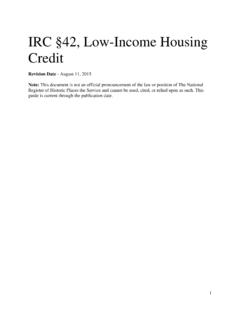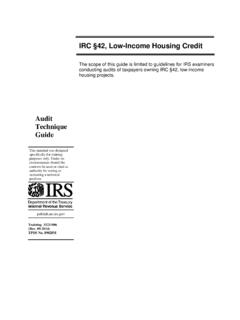Transcription of American Association of Homes and Services for the Aging ...
1 Understanding Low IncomeHousing Tax CreditsAmerican Association ofHomes and Services for the Aging39th Annual Meeting and ExpositionPresented ByDebbie Burkart$$$$ Established by Congress in 1986 to encourageprivate investment in construction andrehabilitation of affordable housing Since 1987, the program has produced over1,625,000 units or approximately 125,000annually Largest single funding source for affordablehousing production in the $$$$National Equity Fund 2 A dollar for dollar deduction against the taxliability of an individual or corporation Not a federal subsidyNational Equity Fund 3$$$$$$$$ State housing Finance Agencies receive from theIRS an annual allocation of $ per capita States develop allocation plans andSponsors/Developers apply for credits Credit amount to a project is based on constructioncosts incurred and begins when units are occupiedby low income families Most types of housing can be developed with theLIHTC but must be residential and rental$$$$$$$$National Equity Fund 4 Syndicators
2 Such as NEF provide equity inexchange for a interest in theLIHTCs and the operational losses that flowfrom a given project Investors receive direct credit againstfederal tax liabilities for their investment inlow income housing $$$$$$$$National Equity Fund 5 Ownership Structure - The LimitedPartnership Sponsor acts as General Partner (GP) GP oversees development team and construction,obtains funding, applies for LIHTCs, coordinatessupportive Services , maintains LIHTC compliance Syndicator acts as Limited Partner (LP) LP forms a partnership with the GP and providesequity in exchange for a interest in the LIHTC sand the operational losses that flow from a givenprojectNational Equity Fund 6$$$$$$$$NEFNEFLIHTC$$$$$LIHTC$$$$$Inves torsProjectsNational Equity Fund 7$$$$FOUR TYPES OF TAX CREDITS1.
3 Rehab/New Construction LIHTC 9% of eligible basis taken over 10 years2. Acquisition LIHTC 4% of eligible basis taken over 10 years only with rehab and only 1 owner in last 10 years,special exceptions may apply$$$$National Equity Fund 8 FOUR TYPES OF TAX CREDITS (Cont d)3. LIHTC awarded with Tax Exempt Bondapplication Must finance over 50% of project Automatic 4% credit taken over 10 years4. Historic Rehab Credit 20% of basis taken in first year only Different IRS sectionNational Equity Fund 9$$$$$$$$How much tax credit is there?National Equity Fund 10$$$$$$$$ housing Credit Terms Eligible Basis Credit Rate Application Fraction Qualified Basis Basis BoostNational Equity Fund 11$$$$$$$$$$$$What is eligible basis?
4 Eligible Basis is the value of the costs incurred by ataxpayer to make a residential property ready for itsintended use. For new construction it s all the costsassociated by building the property; for renovation,it s all the costs associated with the repair of building. An estimate of the Eligible Basis anticipated to beincurred during your project s development periodwill be performed in order to apply for tax credits$$$$National Equity Fund 12 Construction costs including construction period costs such as loaninterest, real estate taxes, water & sewercharges, and insurance Architect s Fees Environmental surveys Relocation Expenses Title and Recording Fees AppraisalsNational Equity Fund 13 Land Acquisition (Reserves) up front operating,replacement (or rent-up reserve andescrow accounts) Permanent Mortgage Fees Partnership Organization Costs (Legal)
5 Marketing Expenses Syndication CostsNational Equity Fund 14$$$$ Credit Rate Published monthly by the IRS Rates are multiplied by the adjusted qualifiedbasis to determine the annual LIHTC amount forwhich the project is eligible -- must lock in yourrate Rehab credit rate is between 8% and 9% and theactual rate will yield 70% PV over 15 years. Thediscount rate is the federal rate and that variesmonthly, which is why the credit can changemonthly.$$$$National Equity Fund 15$$$$ Qualified basis is the amount of eligible basis(less any federal financing) that is attributableto the low income units Qualified basis is found by multiplyingadjusted eligible basis by the lesser of (1) thepercentage of low income units in building or(2)
6 The percentage of floor area attributable tolow income units in the building$$$$National Equity Fund 16$$$$$$$$TDC $5,000,000 minus 1,050,000ineligible costs equals 3,950,000 eligible basis tim es 100 % qualified units equals 3,950,000qualified basis tim es credit rate equals $ 329,825 annual credit amount for ten years National Equity Fund 17$$$$ Basis Boost -- You can increase your qualifiedbasis by up to 130% if your project is located in a qualified census tract (more than 50% of theresidents earn less than 50% of median income )OR a difficult to develop area (where costs are far abovethe national average) HUD publishes a list QCTs and DDAs eligible forbasis boost annually$$$$National Equity Fund 18 TDC $5,000,000 minus 1,050,000ineligible costs equals 3,950,000 eligible basis tim es 100 % qualified units tim es 130% basis boost equals 5,135,000qualified basis tim es credit rate equals $ 428,773 annual credit amount for ten years National Equity Fund 19$$$$ Any federal funds used for construction mustbe subtracted from eligible basis.
7 This is toavoid double federal subsidy. Tax exempt bonds are included as federal financing home and CDBG do not function as federal funds Rather than subtracting federal dollars youcan take 4% credit on entire eligible basis.$$$$National Equity Fund 20$$$$ Rent and income RestrictionsEITHER 20% of units must be reserved for families earning50% of area median income (AMI) OR 40% of units reserved for families earning 60% ofmedian incomeAnd there s Rents for low income units must not be more than30% of targeted household income $$$$National Equity Fund 21$$$$ Leases must be for a minimum of six months Rent and income restrictions last for at least 15years, often longer Minimum Rehab Standard The owner must perform a minimum amountof rehab the value of which is equal to thegreater of $3,000 per unit or 10% of thebuilding s adjusted basis.
8 $$$$National Equity Fund 22 Cost Certifications 10% Carryover 8609 Filing Initial tenant income certification (TIC) Annual compliance and monitoring Record keepingNational Equity Fund 23$$$$ Recapture. If the project does not maintainthe rent and income restrictions, the investorswill be subject to recapture 1/3 of the taxcredits taken and interest on these tax credits. Because of this recapture, you must maintaindetailed records demonstrating the rent andincome of each low income tenant. These mustbe certified annually.$$$$National Equity Fund 24 Flexible $ Money Construction Costs Operating Reserves Social Service Reserves Replacement Reserves Reduces other sources of debt Developer Fee$$$$$$$$National Equity Fund 25 Coordinating Sources of Funding construction, rent subsidies, social Services Managing the Development Team Balancing Social Service and AssetManagement Issues Tax Credit Reporting and ComplianceNational Equity Fund 26 Your role as sponsor, service provider,developer/co-developer?
9 Use an experienced development team Consultant Property Management Company General Contractor Architect Tax and Real Estate Attorney w/ LIHTC expertise Tax Accountant with LIHTC expertiseNational Equity Fund 27 States receive $ per capita allocationfrom the IRS State allocating agencies issue an allocationplan Sponsors/Developers apply for LIHTCs Applications rated by the allocating agencyon a point systemNational Equity Fund 28 Federal law sets aside a minimum of 10% ofcredits for not-for profit project sponsors State s determine how credits are awarded Know your State s priorities Competitive points are awarded to sponsorsserving the lowest income and in some states,special needs groups Competitive points are awarded to projects thathave other funding in place and are ready to gounder constructionNational Equity Fund 29 EASY ANSWER: NEF!
10 Equity contributionNational Equity Fund 30 Annual Credit Amt. $329,829 Credits over 10 Years $3,298,290 Equity price per credit $.75 Total Project Equity $2,448,980 can provide between 30% and 60% of your totaldevelopment costs can enable operating and social service reserves over 90% of all affordable rental housing isdeveloped using tax credits states typically give extra points for special needs,very low income uses and nonprofit involvementNational Equity Fund 31WE KNOW YOU HAVE THEM!National Equity Fund 32










